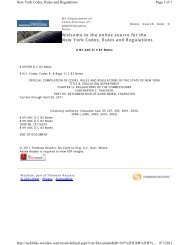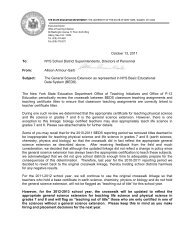ESL Learning Standards - Higher Ed - New York State Education ...
ESL Learning Standards - Higher Ed - New York State Education ...
ESL Learning Standards - Higher Ed - New York State Education ...
You also want an ePaper? Increase the reach of your titles
YUMPU automatically turns print PDFs into web optimized ePapers that Google loves.
Students learning English as a second language will use English to express their opinions and<br />
judgments on experiences, messages, ideas, information, and issues from a variety of perspectives.<br />
They will develop and use skills and strategies appropriate to their level of English proficiency to<br />
reflect on and analyze experiences, messages, ideas, information, and issues presented by others<br />
using a variety of established criteria.<br />
Performance Indicators: See page 20<br />
Advanced<br />
Students watch movie, The Long Walk Home, and a documentary<br />
about the Montgomery bus boycott. They take<br />
notes on the facts of the bus boycott and then write a summary<br />
of the story in The Long Walk Home. They write an<br />
evaluation of the two films by answering the question “If<br />
you were the teacher, which film would you use to teach<br />
about Rosa Parks and the bus boycott, and why?” In small<br />
groups, students share and compare answers.<br />
Performance indicators: 1, 2, 4, 5<br />
English Proficiency Level<br />
Transitional<br />
Students watch a documentary on the Montgomery bus<br />
boycott, take notes, and as a whole class discuss the issues<br />
raised in the film. Then they watch The Long Walk Home,<br />
paying close attention to an antagonist on each side of the<br />
issue. They write a brief character analysis of each antagonist<br />
with a rationale for the filmmaker’s purpose for writing<br />
the two characters into the script and a discussion of how<br />
these characters contributed to or embellished the documentary.<br />
Performance indicators: 1, 2, 4, 5<br />
Students complete Intermediate task and as a whole class<br />
predict TV viewing habits of adults. Each student interviews<br />
three or four adults, tabulates data, and graphs results.<br />
Students engage in a class discussion of similarities/differences<br />
between predictions and results, and between adult<br />
and student viewing habits. In small groups, students discuss<br />
possible explanations for these differences and individually<br />
write a position paper. Papers are shared in class.<br />
Performance indicators: 1, 2, 3, 7, 9<br />
Students complete Intermediate task. From criteria for effective<br />
ads, students create a rubric for assessing degrees of<br />
effectiveness on a scale of 1-4. Using the rubric, students<br />
reevaluate the original ads, ranking each ad in each category.<br />
They compare the objective analysis to their earlier subjective<br />
opinions and, using the writing process, write an<br />
essay explaining what they have learned about advertising<br />
or prepare an effective ad based on the rubric.<br />
Performance indicators: 1, 2, 3, 7, 9<br />
Students complete Advanced task. As a whole class they<br />
analyze data to devise optimal schedule of TV programming<br />
and, in small groups, compare predictions to actual<br />
programming. Groups summarize their findings, compare<br />
their findings to those of other groups, and report them in<br />
letters or e-mails to TV stations with graphs and suggestions<br />
based on findings.<br />
Performance indicators: 1, 2, 3, 4, 5, 6, 7, 8, 9<br />
Students complete Advanced task. Students are given a<br />
variety of magazines (e.g., sports, health, travel, etc.) to be<br />
categorized. They brainstorm product categories and tally<br />
the types of ads in each magazine category. They graph<br />
results, then choose a product, select an appropriate magazine,<br />
and develop an ad for this product. Students present<br />
ads to classmates, and edit according to feedback. Finally<br />
they present a proposal to the manufacturer.<br />
Performance indicators: 1, 2, 3, 7, 9<br />
<strong>ESL</strong><br />
3<br />
Interm<br />
Students complete Intermediate task. Class brainstorms features<br />
that facilitate the use of reference materials (e.g.,<br />
index, pictures, captions, charts, large print, etc.). The<br />
school librarian directs students to reference materials germane<br />
to a topic (e.g., Civil War). Students evaluate materials,<br />
using the established criteria and class-made rubrics.<br />
They select the 10 most useful reference materials and produce<br />
an annotated bibliography for use by other students.<br />
Performance indicators: 1, 2, 3, 5, 6, 7, 9<br />
Students complete Intermediate and Advanced tasks,<br />
expanding scope to include using the Internet as a source<br />
for information and a fourth center. After exploring various<br />
search engines, students generate criteria for effective and<br />
efficient search engines and create assessment rubrics to<br />
rate returns on requests. They develop an annotated list of<br />
useful websites germane to a topic (e.g., Civil War) for use<br />
by other students, organizing sites in categories such as<br />
biographies, histories, maps, or illustrations.<br />
Performance indicators: 1, 2, 3, 5, 6, 7, 9<br />
Continued on next page<br />
CLASSROOM<br />
TASKS<br />
Sample Classroom Tasks 77
















